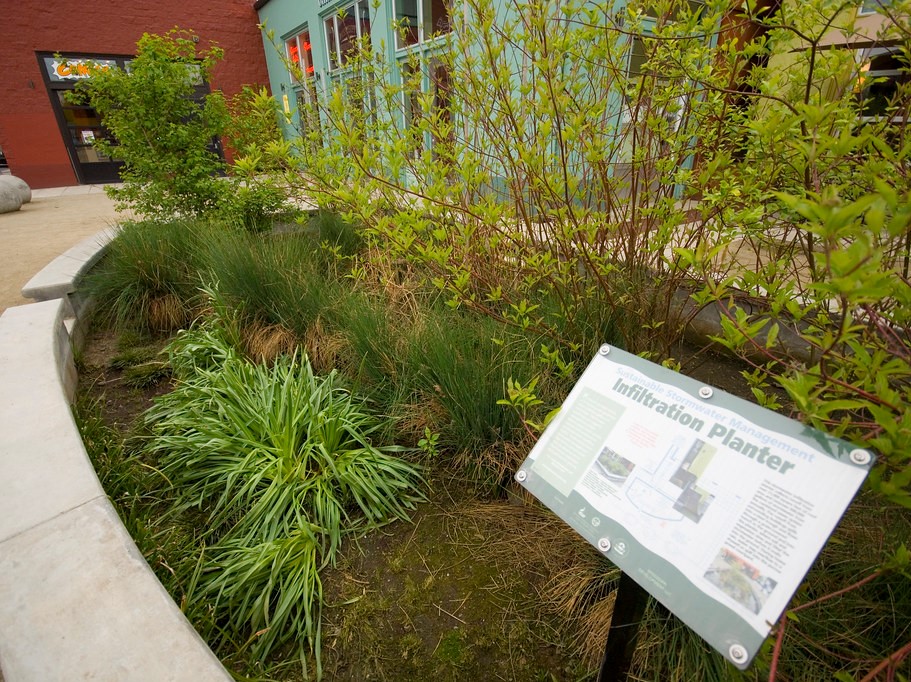
Infiltration Planter
Asset Type : Enhanced
Water Classification:
Stormwater
Combined Sewer Overflows
Stormwater
Combined Sewer Overflows
Construction Rank :
2
O&M Rank :
2
How it Works : Infiltration planters are usually installed between the roadway and the right of way to manage stormwater runoff through infiltration, storage and evapotranspiration. They are commonly seen in cities along streets and sidewalks, and can vary in size, shape, and plant content. The infiltration zone in the planter is lower in elevation than the adjacent surfaces (i.e. sidewalks and roadway). These planters often have an overflow pipe connected to the existing combined sewer pipe for excess runoff. Stormwater planters are designed for small-scale runoff collection and filtration and should be located in areas where the water flow rate is not too strong. Hills and steep slopes usually cause problems for planters because runoff with high velocity will overrun the planter and not be able to infiltrate.
O&M Required : Water-efficient irrigation should be applied for the first two years after construction of the facility, particularly during the dry summer months, while plantings become established. Irrigation after these two years is at the discretion of the owner. Inspect plants and structural components periodically. Remove sediment and clear debris from inlet pipes and curb cuts to maintain proper drainage. Remove sediment and debris and replace mulch (this could be a frequent requirement if the facility design doesn’t include pretreatment). Clean and repair inlets and outlets, embankments, and berm dams. Control erosion, replant as necessary, and remove weeds by hand.
Design Considerations : Planter walls should be constructed of durable, impervious materials, but should not employ chemically treated wood that may leach chemicals into groundwater. Planters should incorporate trees and shrubs where feasible. An overflow should be installed to divert excess water during high-flow runoff events.
Costs : Overall relative costs are expected to be low, with costs dependent upon construction materials and the size of the planter. Costs on a unit basis (cubic foot) are expected to be higher than other BMPs. Costs vary depending on size and materials. For new development and redevelopment, infiltration planters are often less expensive than more conventional stormwater management facilities. Approximately $8/square foot, $400 – $500/year for a 500 square foot planter.
Benefits : Provides filtration of pollutants, as well as infiltration of runoff. Reduces flow rates and volumes. Suitable in areas with limited space and may be used as part of a traditional landscaping plan. The planter should reduce the amount of watering necessary to maintain vegetation. Infiltration planters typically require less piping than flow-through planters and a smaller facility size than traditional swales where native soils allow for infiltration.
References:
Infiltration Planner Clean Water Services
City of Portland Infiltration Planters Overview
Charles River Watershed Association Infiltration Planter Examples
Stormwater Planters Low-Impact Design Fact Sheet
City of Lincoln Nebraska Alternative Stormwater BMPs
Bernalillo County Green Infrastructure and Low Impact Design Guide
Green Building Alliance Stormwater Planter Overview
Green Infrastructure Technology Fact Sheet
City of Portland Infiltration Planters Overview
Charles River Watershed Association Infiltration Planter Examples
Stormwater Planters Low-Impact Design Fact Sheet
City of Lincoln Nebraska Alternative Stormwater BMPs
Bernalillo County Green Infrastructure and Low Impact Design Guide
Green Building Alliance Stormwater Planter Overview
Green Infrastructure Technology Fact Sheet
Image by: Radcliffe Dacanay via https://www.flickr.com/photos/kworth30/2547072270